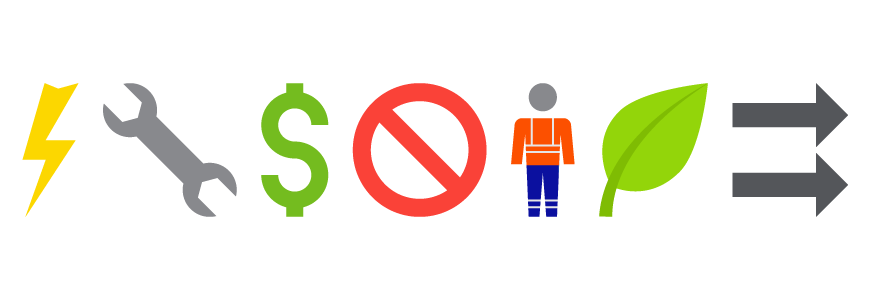The life cycle cost is the total cost associated with your industrial pump from the point of procurement, to the point of decommissioning and disposal. If you’re considering repairing or replacing an existing pump, analysing the life cycle cost of the pump will help Operation or Plant Managers choose between alternative pumping options and decide between repairs or a new purchase.

What costs operators the most over the lifetime of their pump?
If the service life of the pump is approximately 20 years, energy, maintenance costs and repairs account for half the total life cycle cost. The following table depicts the costs associated, and general percentage of costs over the lifetime…
Category |
Inclusions |
% cost over lifetime of pump |
|---|---|---|
|
Energy |
Annual energy consumption for entire pump systems including system controls |
32% |
|
Maintenance and repairs |
|
20% |
|
Initial cost |
Includes custom engineering, bidding, testing and inspection |
10% |
|
Downtime |
Loss of production |
9% |
|
Operating expenses |
Labor man-hours |
9% |
|
Environmental |
|
7% |
|
Disposal |
|
4% |
*Note: figures are from Top 10 Global Chemical Manufacturers, FY 2006
Discover the video above to learn more about the life cycle cost of your pump!
Why should I be concerned about the life cycle cost of my pumping system?
Pumps, and the parts they are comprised of, make up for approximately 20-25% of all components used in the processing industry. The purchasing price is only a small portion of the total life cycle cost incurred, and maintenance, repair and energy account for nearly half. Often, those purchasing the pump are only considering the initial investment, not the long-term costs associated that could influence their budget or KPIs down the track.
Although operators have little control over environmental, disposal or installation costs, there is great control on maintenance, energy and downtime costs. The potential cost-savings could allow for greater resources for your plant and ensure KPIs and production schedules are met.
If you’re responsible for managing plant and equipment, Global Pumps recommend using tools such as life cycle cost analysis to decide whether to pay a higher initial cost to avoid unwanted and unexpected maintenance and other costs.
Now that I know about the life cycle cost of my pumps, how do I reduce costs?
The following suggestions should be considered prior to purchasing your new pumping system. If you already have a pump, there are some top tips included that will see life cycle costs reduce for your site.
Reducing energy costs
The amount of energy pumps use is relative to the individual pump and should be viewed in the context of the application. Over time, the motor will slow, which may cause greater energy usage. However, there are a few more considerations that Global Pumps outline:
- is your pump too big for your system? Installing an oversized pump into a pre-existing system can cause the system to operate at a higher flow rate, increasing the energy consumption and reducing the life of the pump.
- is your pipework efficiently set up?
- what is the viscosity of the media being pump? The energy use depends on the nature of the liquid being pumped. If the viscosity changes, or the amount of product increases, so will the pump’s energy requirements.
- is the pump operating near its best efficiency point? If the pump system is operating far away from its best efficiency point, operating costs may increase.
If you have an existing system that consumes a lot of energy and are looking for replacements, Global Pumps recommend the following during pump selection:
- select a pump based on the flow rate and liquid characteristics. Ensure it is suitable for the application and production demands.
- do not oversize or undersize your pump selection. One suggestion is to install two or more pumps in parallel and running these based on your system requirements. This could reduce your energy costs by 20 percent.
- use variable speed drives - sometimes referred to as variable frequency drives.
Reducing maintenance costs
Although reactive maintenance is sometimes the most suitable maintenance strategy, Global Pumps recommend the following maintenance practice.
Type of pumps |
Recommended maintenance |
|---|---|
|
Group 1 |
Proactive maintenance and predictive maintenance practices |
|
Group 2 |
Proactive maintenance will cost, however reactive maintenance at the cost of plant productivity is risky. |
|
Group 3 |
Reactive maintenance approach is cost effective. |
Through the implementation of an effective maintenance schedule, you can effectively reduce the life cycle cost of your pumps and ensure KPIs are met.
Life cycle cost analysis helps Operations and Plant Managers make better choices during the procurement of new industrial pumping systems.
If you are considering replacing or repairing your pumping system, and require more information, speak to a Global Pumps team member. With over forty years’ experience advising industrial pumps, Global Pumps can ensure you’re operating efficiently and effectively.
Our team are here to help your plant operate to the best of its ability, and ensure you reach your production objectives and KPIs. Contact Global Pumps for more information today!

